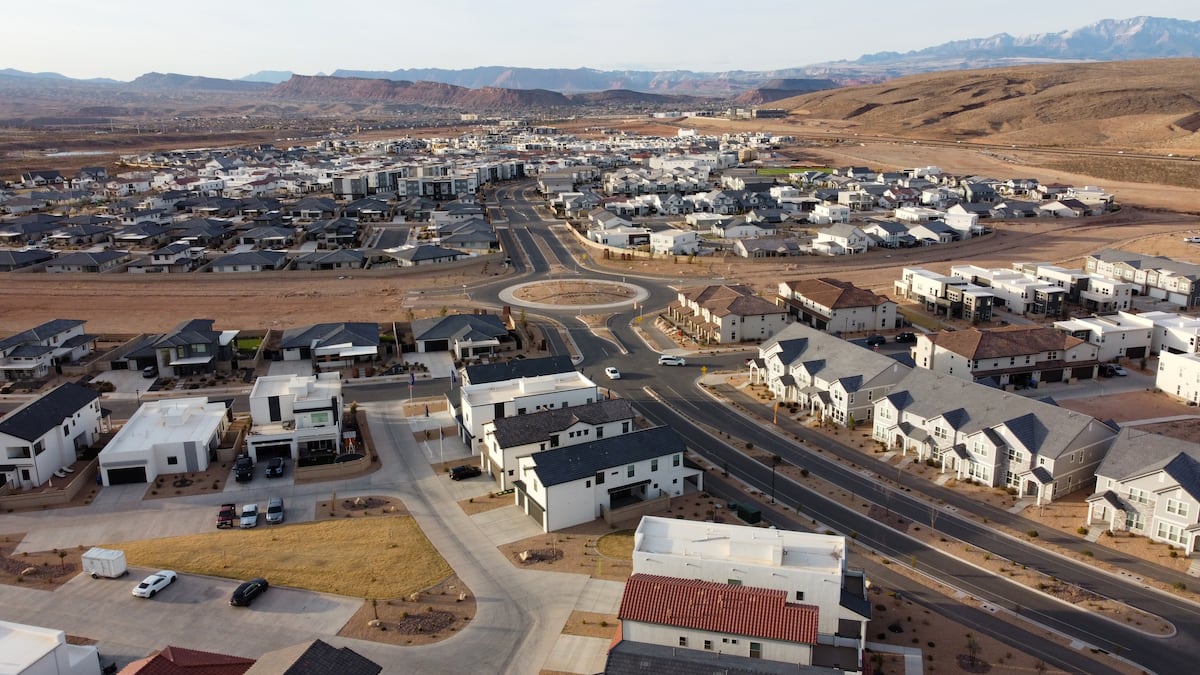County cities aim to conserve 1.7 billion gallons over the next 5 years
(Jud Burkett | Special to The Tribune) A variety of homes and condominiums in various states of construction in the Desert Color neighborhood near the Arizona-Utah state line in St. George, Thursday, March 20, 2025.
St. George • Already required to do water conservation by the book, southern Utah’s Washington County Water Conservancy District and its eight member cities have decided to get on the same page.
Last week, Santa Clara elected officials joined their counterparts in the other seven cities to approve the 2025 Joint Agency Regional Water Conservation Plan, the first of its kind in Utah.
Doug Bennett, the district’s conservation manager and point man in the effort, also hailed the plan’s approval.
“Adoption of this joint plan by eight cities demonstrates the collective commitment to protecting our shared water supply,” he said. “This is a great milestone for the region.”
Washington City Mayor Kress Staheli touted the fact that his city was the first to adopt the state’s first regional water conservation plan.
“This is an example of the Dixie Spirit here in southern Utah, where communities and residents continue to come together to tackle difficult and unique challenges, like managing a limited water supply in the desert,” Staheli said. “We all depend on the Virgin River Basin for our water supply, so it’s important we are all on the same page when it comes to conservation initiatives. This collaborative plan helps ensure that we can continue meeting water demands for residents throughout Washington County well into the future.”
Saving time and money
State law requires all Utah cities and water districts to submit water conservation plans every five years. That can cause problems, Bennett explained, when cities and districts are on different schedules, meaning the plans they produce don’t jibe and are quickly outdated as new regional policies are put in place.
At St. George Water Services Director Scott Taylor’s suggestion, and with the Utah Division of Water Resources’ blessing, the district decided to submit one collective plan rather than eight individual municipal plans. According to district estimates, that will save district cities a combined $100,000-plus that they would have otherwise spent to hire consultants.
Bennett said it also saves the state time and money.
“Because where [state officials] would have had to review eight individual plans on eight individual schedules, they are now reviewing a single plan,” he said.
Still, not much in the plan is new. The information in the regional plan, which outlines its effort to conserve water, draws heavily on the district’s 20-year master plan it unveiled in July 2023. Over the timeframe — 2025 through 2029 — covered by the new five-year regional plan, Bennett explained, the district aims to cut water usage by 7.7%, using 2024 as the baseline year.
That would reduce water use by 5,200 acre-feet, nearly 1.7 billion gallons of water by 2030. An acre-foot is nearly 326,000 gallons, enough water to cover an acre of land with one foot of water, and roughly the amount of water used by two single-family homes in an average year.
Most of that reduction, Bennett said, would come from voluntary upgrades or retrofits — higher-efficiency water fixtures, for example — to homes built before 2023, when the district implemented stringent development standards.
The plan further notes the ultra-water-efficient standards, which the district implemented earlier this year and could lead to the construction of new homes that use 30% less water than current ones.
Next up: water shortage plan
Among other things, the regional plan calls for a continued effort to get businesses and residents to replace lawns with more water-efficient landscaping. To date, the district’s Water Efficient Landscape Program has resulted in district cities replacing three million square feet of grass.
With the regional conservation plan in place, the district’s focus is on getting cities to sign off on a draft water shortage contingency plan, various iterations of which have been circulating since last spring. In the latest draft, the Washington County Water Conservancy District’s board would be empowered to declare a water shortage and implement targeted reductions in water use, but officials in member cities would decide how best to meet those targets should a severe drought, earthquake or other natural disaster dry up the water supply.
District officials hope to have the plan in place before the end of the year.

